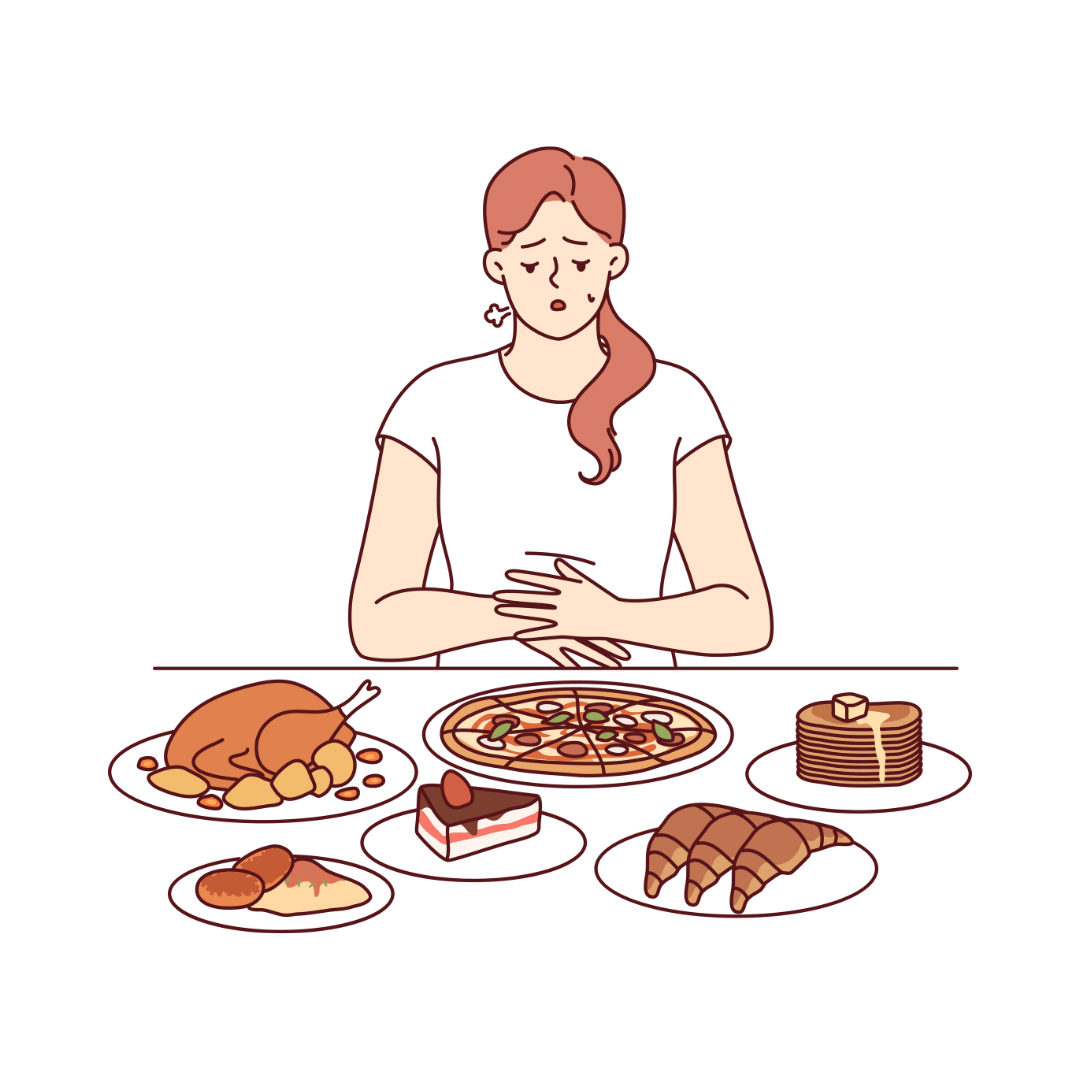Understanding the Cycle of Binge Eating
Binge eating is more than just overeating on occasion, it is a serious and often complex pattern of behaviour that can lead to emotional distress, physical health problems, and a significant impact on daily life. Understanding the cycle of binge eating is the first step towards breaking free from it.
In this blog post, we will dive deep into the causes, the stages of the binge-eating cycle, and how individuals can take steps towards healing and recovery.
What is Binge Eating?
Binge eating is characterised by episodes of consuming large amounts of food in a relatively short period, often to the point of discomfort or even pain. People who binge eat typically feel a loss of control during these episodes. Unlike other eating disorders, binge eating is not followed by purging behaviours like vomiting or excessive exercise, which is why it often leads to weight gain and associated health issues.
The cycle of binge eating doesn’t just revolve around food. It is tied to complex emotional, psychological, and sometimes physical triggers that perpetuate the behaviour. Let’s break down the stages of this cycle.

The Cycle of Binge Eating
1. Emotional or Situational Trigger
The binge eating cycle usually begins with a trigger, an event, emotion, or feeling that sets off the desire to overeat. Triggers can vary greatly between individuals, but often fall into two broad categories: emotional and situational.
- Emotional triggers might include stress, anxiety, depression, loneliness, boredom, or even happiness. For some, eating becomes a way to numb negative emotions or amplify positive ones.
- Situational triggers might be social settings (like parties), seeing particular foods, or even following a restrictive diet that leads to a sense of deprivation.
These triggers create a sense of discomfort or tension that the individual doesn’t know how to manage in a healthy way, so they turn to food as a coping mechanism.
2. Craving and Urge to Binge
Once the trigger is activated, the individual experiences a strong craving for food, often specific types like high-calorie, sugary, or fatty foods. These cravings can feel overpowering and are usually difficult to resist, particularly because food is often used as a way to self-soothe or avoid the discomfort caused by the trigger.
Cravings are not just about hunger but are deeply tied to the brain’s reward system. The anticipation of eating these foods can cause a rush of dopamine (the “feel-good” neurotransmitter), making the desire to binge almost irresistible.
3. The Binge
In this phase, the individual consumes a large amount of food, often much more than a typical meal or snack. The experience of bingeing can feel dissociative, as if the person isn’t fully present or in control. Many describe the experience as a temporary escape from their emotional or psychological discomfort.
Common characteristics of the binge include:
- Eating more rapidly than usual
- Eating until feeling uncomfortably full
- Eating large amounts of food even when not physically hungry
- Eating alone due to embarrassment about how much one is eating
- Feeling ashamed, disgusted, or guilt afterward
4. Post-Binge Guilt and Shame
After the binge, the temporary relief by food quickly dissipated. Instead, the individual is often left with intense feelings of guilt, shame, and self-loathing. They might criticise themselves for losing control or for the negative impact the binge will have on their health or weight. This emotional fallout only reinforces the emotional triggers that started the cycle in the first place.
This phase is crucial because the negative feelings often contribute to the desire to binge again, creating a vicious cycle. Instead of breaking the loop, many feel trapped in an endless pattern of binge eating to relieve emotional pain, followed by more guilt and shame.
5. Attempt to Restrict or Control
After a binge, many individuals vow to “make up” for their behaviour by restricting their food intake. This might take the form of skipping meals, dieting, fasting or over-exercising. The intention is often to regain control, lose weight, or prevent future binges. However, this restrictive behaviour can backfire.
Restriction can lead to both physical and emotional deprivation, which increases cravings for the very food the person is trying to avoid. Over time, this restriction can lead to even stronger cravings and the sense of “breaking” the diet, triggering another binge episode. Thus, the cycle repeats.

Why Does the Binge-Eating Cycle Persist?
These are several reasons why the cycle of binge eating can become so deeply entrenched.
These include:
Biological Factors
- Brain Chemistry: As mentioned earlier, binge eating activates the brain’s reward system by releasing dopamine. Over time, the brain becomes conditioned to associate binge eating with relief or pleasure, making it harder to resist cravings.
- Hormonal Imbalances: Leptin and ghrelin, the hormones that regulate hunger and fullness, can become disrupted in people who binge eat, leading to irregular hunger cues and more frequent overeating.
Psychological Factors
- Low Self-Esteem and Negative Body Image: Individuals who struggle with binge eating often have low self-worth and may use food to cope with negative feelings about themselves. Paradoxically, the cycle of binging and guilt reinforces these feelings, making recovery more challenging.
- Perfectionism and All-or-Nothing Thinking: Many individuals who binge eat engage in black and white thinking. They believe they must follow strict rules about eating, and any deviation (like eating “forbidden” foods) leads to a sense of failure, which can prompt a binge.
Social and Environmental Factors
- Diet Culture: Society’s obsession with thinness and dieting can exacerbate the binge eating cycle. The pressure to conform to unrealistic body standards often leads to extreme dieting, which can trigger binge episodes when the diet inevitably breaks.
- Access to Food: In environments where high-calorie, palatable foods are readily available, it is easier to turn to food for comfort or binge impulsively.

Breaking the Cycle of Binge Eating
The good news is that the cycle of binge eating can be broken. While it may be challenging and require time, support, and effort, recovery is entirely possible.
Here are some strategies that can help:
- Recognise Triggers
The first step is identifying the triggers that lead to binge eating. Keeping a food and emotion journal can help you pinpoint situations, emotions, or thoughts that prompt bingeing. By recognising these triggers, you can develop healthier coping strategies. - Practice Mindful Eating
Mindful eating is a practice that encourages paying attention to the sensory experience of eating and listening to your body’s hunger and fullness cues. It involves eating slowly, savouring each bite, and becoming more aware of how food makes you feel. This practice can help reduce the dissociative feeling that often accompanies a binge. - Challenge Restrictive Dieting
Restrictive diets tend to fuel binge eating by creating feelings of deprivation. Working toward a more balanced, flexible approach to eating - where no food is off limits - can reduce the urge to binge. This is often referred to as “intuitive eating,” where the focus is on listening to your body’s needs rather than following external rules about what and when to eat. - Seek Professional Help
Many people find it helpful to work with a therapist, dietitian, or life coach who specialises in eating disorders. Cognitive Behavioural Therapy (CBT), in particular, has been shown to be effective in treating binge eating by helping individuals reframe negative thought patterns and develop healthier behaviours. - Build a Support System
Recovery is easier when you have a network of people who understand what you’re going through. Support groups (both in person and online), friends, or family members can provide encouragement and accountability as you work through the process of healing. - Focus on Emotional Wellbeing
Since binge eating is often tied to emotional distress, it is crucial to find healthier ways to manage stress, anxiety, and other emotions. Practices such as meditation, yoga, journaling, or engaging in hobbies can help alleviate the emotional triggers that lead to bingeing.
Conclusion
The cycle of binge eating is a challenging and often overwhelming pattern, but it is important to remember that it can be broken. Understanding the emotional, psychological, and physical factors that contribute to binge eating is the first step towards recovery. With patience, self-compassion, and the right support, individuals can develop healthier relationships with food and themselves. Recovery is not about perfection, but progress, and each step forward is a victory in itself.
Copyright © 2025 · Food Addiction UK


